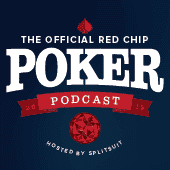Doug Hull and Ed Miller lead today’s conversation on short-stacking. This will be useful for anyone who likes to play shorter stacks, or plays in the game where their opponents are frequent the table with tiny columns of chips.
Hull and Miller focus on a few key ideas in this appropriately short episode:
- short stack play general concepts
- fundamental differences between short stacks and deep stacks
- how hand strength changes as your stack grows and shrinks
- how to visualize short vs. deep-stacked play

How Deep Were You?
Hull starts out by reminding listeners to always consider stack size when analyzing hands. He often has to stop students just to ask, “How deep were you?” as they rattle off a hand history.
How deep you are will change which hands are reasonable to play. Having a $60 stack vs. having a $200 stack in $1/$2 NLHE is a big difference, and you can imagine being super-deep with $1000 makes an enormous difference in which hands you choose to play, and how you choose to play them.
The two discuss Miller’s short stack chapter in Getting Started in Hold’Em, which is still relevant today.
Hull paraphrases Miller’s short stack strategy as: “Have the best hand pre, bet as much as they are going to call, and basically ship the flop.”
Short Stacking in Cash vs. Short Stacking in Tournaments
Miller talks about how he gets questions on Twitter (ask him yours @edmillerpoker) about how short-stacking applies to tournament play.
Clearly in a cash game you are dealing with 100BB-type stacks, whereas a tournament features many 40BB & under stacks that are less likely to call your shove for their tournament life. Miller clarifies that the short-stacking advice he gives for cash does not necessarily carry over into tournament poker.
And this, Hull says and Miller concurs, is why cash game players “salivate over tournament players” who bust out and join their cash game. Tournament players are better-calibrated to smaller stack sizes, whereas cash game players are used to deep-stack play, which fundamentally changes which kinds of hands are playable.
Playing vs. Short-Stacked Opponents
Even if you’re a deep-stacked cash game player that always stays topped off at the max buyin, you need to understand short-stacked play because many of your opponents will be short stacked. This is particularly true the lower you go in stakes.
You should understand how to “out-short-stack a short stack” by playing better than they do. So what kinds of hands are going to go up in value vs. a short-stacker? Which hands go down in value vs. a short stacker?
Hull and Miller have been working on a Push/Fold book and looking hard at the math and decisionmaking dynamics at 12BB and under. What they found looking at the Nash Equilibrium numbers, the difference between 2BB and 12BB shows that bigger broadway hands like QJ or KJ go up in value as your stack size goes down. The suited connectors — or suitedness in general — means less and less as your stack size decreases. In other words, big cards matter to short stacks.
Miller concurs the entire preflop strategy changes between 2BB, 10BB, 20BB and 40BB. But if he had to boil those changes down to two concepts, that would be: “Big cards become more valuable the shorter-stacked you are — hands like A9o KTo Q9o, with two ‘biggish’ cards, increase in value. Suited connector-type hands decrease in value as stack size decreases.”
Remember that suited connectors have additional equity as bluffing hands if you’re deep stacked, that’s a huge reason we play them. If you’re short, they lose their edge.
Hull says suited connectors are a bit of a lottery. You buy your ticket and hope to hit a board that nuts your hand, or at least gives a great opportunity to barrel and take it. You want to make sure that lottery jackpot is big enough to get into the hand in the first place. Versus a short stack, it usually isn’t. Versus a deep-stacked opponent, the implied odds can behoove you to mix it up with suited connectors.
How Straddles & SPR Affect Stack Depth
One commonly overlooked strategy consideration in live poker is the straddle. Many players underestimate just how much this changes effective stacks — it effectively cuts them in half. Your 100BB instantly becomes a 50BB stack. A 25BB stack becomes a very short 12.5BB stacks vs. a straddle.
See a raise vs. that straddle, and even with 100BB, you are effectively playing short-stacked poker. Short-stacked strategy goes hand-in-hand with SPR. You need to realize that your stack-to-pot ratio after a straddle, some limps, a raise and some calls can put you in short-stack mode before you even realize it.
Hull reminds everyone that big cards like low SPRs, and suited connector lottery-type hands like huge SPRs. You can’t do much bluffing with suited connectors with a low SPR, and you lose an important benefit. Sure, suitedness matters in big multi-way pots, but big cards are the golden ticket there.
In these situations where you’ve got a low SPR, you’re going to be committing on the flop. Without a chance at holding the best hand on the flop most of the time (usually because you lack big cards), your short-stack commitment is dubious. Poker is an information game, and the lower the SPR, the less information you’re going to get about the hand before you have to commit your whole stack.

this was a great podcast I played at Borgata right after i listened to the podcast played $1 $2 with 40 BB stack worked it up 75 BB right from get go but slowly lost every chip profit and all. Here is what happened I realized i was playing bad from the start I might have raised twice during the entire 2hr session I played the exact opposite of what the pod recommended Instead of raising i limped away and you were dead on Limping is a recipe for slow disaster The only reason i played the limp style was because i was gunning for a tournament which never took place. The nightly $120 tournaments were cancelled but not according to the blog I wanted to make enough to cover half the buy in . Achieved my goal only to find out the tournament was cancelled because of the fall open. I should have called but i depended on the blog for accurate info. Figured i would spend the rest of the night trying to increase my winnings only to lose it all soon after. I learned a few lessons Never try to grind with less than 150 BB I just happened to get lucky at the get go with strong hands The other lesson is never limp unless its necessary or try to avoid it at all costs . Wondering what your take is on my comment